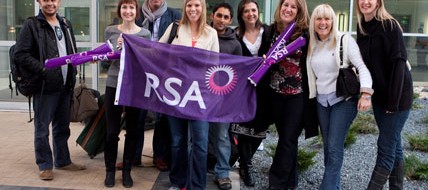After a long absence, I was recently lured back into reading one of the popular HR trade magazines on the basis that it urged readers to learn from a particular firm’s prizewinning HR team. Under the heading “What you can learn from RSA: The happy couple.” People Management revealed what it takes to “scoop the top prize in the 2012 CIPD People Management Awards”.
I generally avoid these magazines largely because I get frustrated at the frequency with which articles help organizations (and sometimes the consulting firms they hire) make spurious claims about their own people management initiatives that seemingly have an incredible business impact. Such claims are often made with so called “evidence” when in fact the evidence used is often flimsy or very poor, and there is little critical evaluation made at all – essentially, the article becomes a very rose-tinted view but can have a significant influence on other HR practitioners.
This kind of overhyped article is dangerous as it creates a sense that everyone should do the same, and this one is no different. It focuses on how the organization has attempted to measure and increase employee engagement with apparent huge success in business performance terms. But if we take a little look at these claims, what can we uncover?
Firstly, in using the measurement system (Gallup’s Q12) adopted by this firm, it is not really measuring employee engagement at all, at least not in the way that many people understand the concept (see the CIPD Factsheet on Employee Engagement.) As Bakker and Leiter (2010) advise:
“Gallup’s engagement concept seems to overlap with well known traditional constructs such as job involvement and job satisfaction”[i]
While Professor Riccardo Peccei recently articulated:
“Gallup’s Q12 scale…does not actually assess individuals’ experience of engagement…it measures the antecedents [precursors] of engagement in terms of perceived job resources”[ii]
Now, this is very different to what the article implies. If we take at face value the claim that there is a meaningful relationship between the firm’s measurement of engagement and one of its key business outcomes (customer service), perhaps they should claim that there is a positive relationship between staff who believe that they have better job resources and their ability to provide better customer service. Framing it within a wider employee engagement context conjures a much broader sense of what the firm believes it is measuring, addressing, and achieving – the article goes on to talk about a number of other initiatives that may well drive engagement but these are not necessarily ones that their measurement scale can get any good evidence around. Worryingly, the article advises that:
[This firm] “…has one word that sums up turning employee engagement around in only three years: rigour”
I don’t believe many HR functions really understand the level of rigour that they actually need and that what they are actually doing is often skewed from what they believe to be the case. As I found in the last two years with King’s College London’s State of HR survey[iii], most measurement of employee engagement is actually through re-using old concepts such as job satisfaction and commitment and that much employee engagement as defined by many organizations is likely to be different to how these organizations measure it.
Additionally, while there is widespread recognition of how important engagement is, organisations are not all necessarily talking about the same idea – i.e. engagement within one firm may not be of any relevance to others at all. This has very real implications in terms of whether organisations can use common approaches (such as Gallup’s Q12) to develop credible data to help with diagnosing key HR priorities, informing appropriate HR interventions and in measuring the impact of HR activities.
The use of such generic and narrowly constructed tools also has significant implications on whether an organisation can really use its engagement data together with business performance outcomes – to demonstrate a clear link between HR strategies and such outcomes, which this article implies through “correlations” it has found (as opposed to claiming that their engagement increases cause performance increases). The King’s survey findings indicate that many organizations have a limited ability to use engagement effectively such that they achieve the kind of performance they desire and this is despite the significant level of resources that may be invested in this particular aspect of HR functional activity.
[i] Work Engagement – A Handbook of Essential Theory and Research Edited by Arnold B. Bakker, Michael P. Leiter (Routledge, 2010)
[ii] Riccardo Peccei – Employee Engagement: An Evidence-based Review in Managing Human Resources (Wiley, 2013)
[iii] The State of HR 2013 (www.thestateofhr.com )

Comments are closed